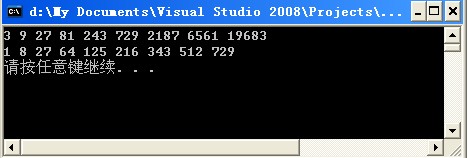今天調試程序的時候,遇到了這樣一個問題
bool check(int elem);
vecot<int>v; ...
pos=find_if(v.begin(),v.end(),not1(check))竟然出錯,查找資料之後,發現,原來原因如下:
ptr_fun做的唯一的事是使一些typedef有效( 仿函數類的operator()所帶的參數的類型和它的返回類型。對於binary_function,你要指定三個類型:你的operator的第一個和第二個參數的類型,和你的operator地返回類型; 而這兩個基類 typedef 了argument_type、first_argument_type、second_argument_type和result_type 這幾種類型 )。就是這樣。not1需要這些typedef,這就是為什麼可以把not1應用於ptr_fun,但不能直接對check應用not1。因為是低級的函數指針,check缺乏not1需要的typedef。 www.2cto.com
not1不是STL中唯一有那些要求的組件。四個標准函數適配器(not1、not2、bind1st和bind2nd)都需要存在某些typedef
c++標准程序庫提供的一些結構如下:
[cpp]
template<typename Arg,typename Result>
struct unary_function{
typedef Arg argument_type;
typedef Result result_type;
};
template<typename Arg1,typename Arg2,typename Result>
struct binary_function{
typedef Arg1 first_argument_type;
typedef Arg2 second_argument_type;
typedef Result result_type;
};
not2也是一樣的道理,not2是用於一個含有兩個參數返回值為bool的函數
[cpp]
pos=find_if(v.begin(),v.end(),not1(ptr_fun(check)));這樣是正確的。
[cpp]
#include<iostream>
#include<string>
#include<vector>
#include<functional>
#include<algorithm>
using namespace std;
bool check(int a){
if(a%2==0){
return true;
}else{
return false;
}
}
int main(){
int a[]={1,2,3,4,5,6,7,8,9,10};
vector<int>v(a,a+10);
vector<int>::iterator it=find_if(v.begin(),v.end(),not1(ptr_fun(check)));
cout<<*it<<endl;
system("pause");
return 0;
}
mem_fun_ref和men_fun是針對成員函數而設計的函數適配器
[cpp]
class Person{
public:
void print() const{
...
}
}
int main(){
vector<Person>v;
...
for_each(v.begin(),v.end(),men_fun_ref(&Person::print));//調用成員數
}
[cpp]
class Person{
public:
void print() const{
...
}
}
int main(){
vector<Person*>v;
...
for_each(v.begin(),v.end(),men_fun(&Person::print));//調用成員數
}
知道差別了嗎
[cpp]
#include<iostream>
#include<vector>
#include<algorithm>
#include<functional>
#include<cmath>
using namespace std;
template<typename T1,typename T2>
struct fopow:public binary_function<T1,T2,T1>
{
T1 operator()(T1 base,T2 exp) const{
return pow(base,exp);
}
};
int main(){
vector<int>v;
for(int i=1;i<=9;++i){
v.push_back(i);
}
transform(v.begin(),v.end(),ostream_iterator<int>(cout," "),bind1st(fopow<float,int>(),3));
cout<<endl;
transform(v.begin(),v.end(),ostream_iterator<int>(cout," "),bind2nd(fopow<float,int>(),3));
cout<<endl;
system("pause");
return 0;
}
